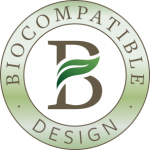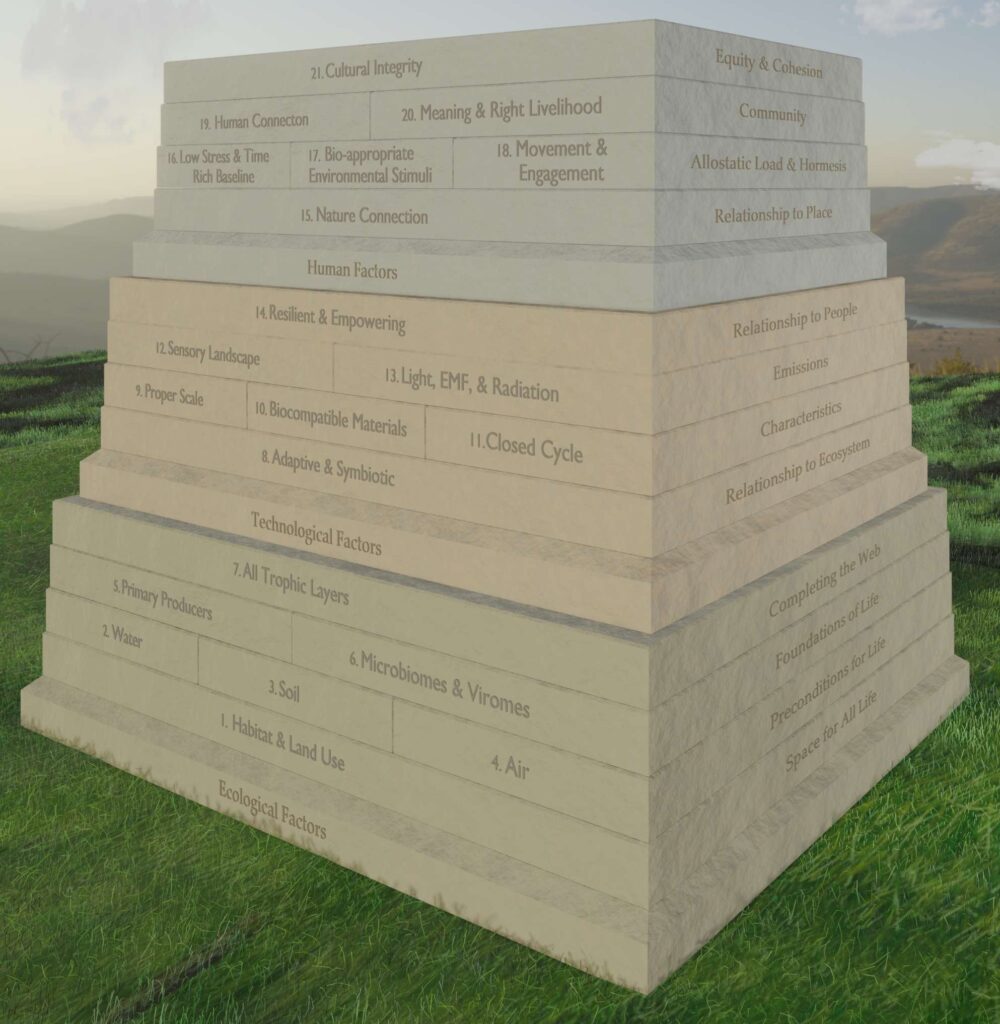Biocompatible Design Standards

The Biocompatible Design standards are a critical part of the Integrated Regenerative Design framework, providing a clear set of 21 principles for designing, implementing, and maintaining systems that are ecosystemic and biocompatible.
Each of the 21 principles is further articulated in a set of positively-worded design guidelines and objectives that are organized to allow them to be easily applied to almost any form of human technology.
Development History
The concept of developing a coherent and whole-systems set of design principles for creating regenerative and ecological design outcomes was the outgrowth of the research started in 2016 to define the foundational elements needed to build the framework of Integrated Regenerative Design.
One of factors identified which helps explain the current lack of wide-spread adoption of good design practices is the absence of a proper definition of what actually constituted ecological design practices in the first place. The majority of standards already under development only address a specific segment of design (such as architecture or landscape design) and then only from a fairly narrow perspective.
The proliferation of piecemeal standards makes the job of design professionals much harder. Anyone attempting to take a whole-systems approach to regenerative design will often end up attempting to work with multiple standards, each of which is written using different terminology and that lays out requirements in slightly contradictory ways.
What is needed is a single, coherent set of design principles that lay down the challenge for design professionals to fundamentally rethink how they define successful design.
Contributors that had experience with regenerative design techniques all expressed that there is a mostly unspoken set of principles that is generally embraced by those trying to move technology towards a more ecological model— in the direction of our technological landscape behaving more like a sustainable ecosystem itself.
So one of the key elements of the IRD framework became the Biocompatible Design Standards, a set of broad design principles and that are each broken down into a set of specific design directives that are worded in positive terms. The goal is to help designers think more deeply about what they should be doing instead of what they shouldn’t be doing.
The result at this point is 21 design principles divided into three broad categories: Ecological Factors, Technological Factors, and Human Factors.
The Definition of Biocompatible
The term biocompatible has so far mostly been used in the medical field to refer to a material that can be left in contact with human tissue for long periods of time without causing harm. Items such as artificial hips, pacemakers, and prosthetic limbs all have to be made from biocompatible materials.
The problem is that we are now so deeply surrounded by the technology of modern society that it is having a profound and, in many cases, negative effect on our long-term mental, physical, and emotional well-being. Biocompatible Design extends that idea of biocompatible to refer to technologies that are designed to not create negative long-term outcomes, but are instead designed to nurture the well-being of people (and all life) in a sustainable and long-term way.
Since we are constantly in intimate contact with the technologies that we have created to support us, we need to begin insisting that these technologies be biocompatible in the broadest sense of the word: that they are deeply compatible with both us and the ecosystems that support our health and happiness. In other words, biocompatible technologies are those that are compatible with all life, helping create health, resilience, diversity, equity, beauty, and happiness.
The Biocompatible Design approach is an attempt to create a set of design principles that address the whole range of issues that must be considered when evaluating whether a technology is biocompatible, and to structure those design principles so that they are broadly applicable across all different forms of technology.
Goals of the Biocompatible Design Standards
The goals of the Biocompatible Design Standards are:
- To develop a minimum spanning set of design principles that, when taken together, create a coherent and whole-systems approach to designing and implementing the whole range of human technologies in ways that are ecological, regenerative, and biocompatible.
- To create design outcomes that are regenerative to the Earth and all its inhabitants.
- To focus on positive design directives that emphasize good design practice instead of focusing on prohibitions. Negative and restrictive language should come secondary to positive principles and be used to provide scope, context, and limits where needed.
- To write the principles and design directives directly in the language of the professional designers (engineers, scientists, architects, urban planners, etc.) who will be responsible for implementing them.
- To make the design directives specific and concrete enough that evaluation of success is easy to achieve.
- To fully embrace the challenge of creating new and deeply ecological technologies that move us well beyond the damaging outcomes evident in many of our existing extractive and consumptive approaches, towards outcomes that are deeply regenerative and restorative.

